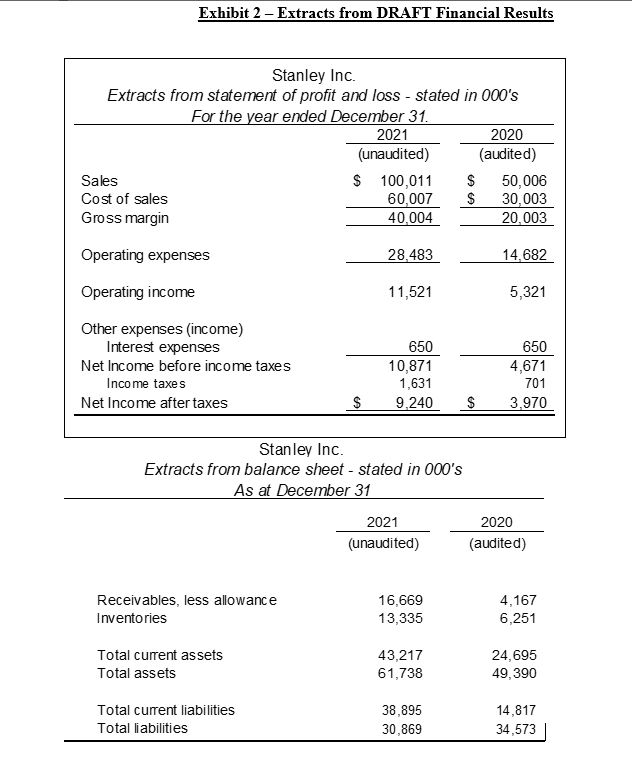Question
You are an audit senior with the firm of Mike and Kiwi LLP. You were just informed that you will be taking over as the
You are an audit senior with the firm of Mike and Kiwi LLP. You were just informed that you will be taking over as the in charge auditor to a new client for you, Stanley Inc for the year ended December 31, 2021. The previous incharge had to leave the job before the end of the audit to be with his wife who gave birth to their twin boys 6 weeks earlier than expected. The incharge did not have a chance to check the work done by the audit trainees.
Your firm has audited Stanley Inc. for the past 6 years and the management letter each year has revealed several control deficiencies. While your firm has identified several errors in the financial statements in the past, management always agreed to some of the adjustments your firm identified as material and accordingly have always received an unqualified opinion.
The draft audit report is dated March 15, 2022.
Exhibit 1
Description of Stanleys Operations
Stanley Inc. is a privately held company that was founded in 2007 by Andy Summer, who is also Stanleys CEO. In 2007 Andy sold 25% of his company to a group of private investors. The investors receive quarterly dividends that are calculated based upon a combination of sales and net income. The investors, all experienced business-people, serve as Andys board of directors and give him advice on the strategic direction of the company. The Board relies on the external audit to provide them with assurance that their dividends are based on reliable figures.
Stanley buys computers and related equipment in bulk at wholesale prices and resells these items at a markup to a loyal base of corporate customers. While this is a competitive industry, demand is growing and Stanley stands out with its excellent customer service. Andy is very involved in most of the operating decisions. To ensure staff continue to provide excellent customer service and act with integrity, he plans to implement a code of ethics at some point in the future.
Stanley operates five warehouses, each carrying a mix of inventory items. In total there are three main categories of inventory, including:
- computer hardware standard
- computer parts and peripherals and
- computer software.
The first type of inventory, computer hardware, consists of specialized computer hardware, desktop computers, and laptop computers. This inventory is more costly than other types of inventories. While it generates a higher profit margin, new technology is always emerging that customers are asking for. Because the company makes inventory orders months in advance, Stanley occasionally overestimates demand. After three or four months products are usually difficult to sell, but they are kept because most can be returned to the supplier.
The second type of inventory relates to standard computer parts and peripherals, such as monitor and printers. This type of inventory generates a significant portion of Stanleys sales. The third type of inventory is software, ranging from operating systems to business applications (such as financial reporting software).
This year, Stanley implemented an integrated computer system to manage the general ledger as well as inventory, purchases, and sales. The system was developed by external consultants and is maintained by Stanleys IT department. Stanley is confident that this new system will result in more accurate financial information and statements.
To help retain the sales team and motivate and retain senior management, in April 2021 the Board approved a bonus scheme for the sales team and senior management based on sales as an added form of compensation.
On May 30, 2021 Monica Fung was hired as the controller and reported to the CEO. Monica replaced the previous controller who had resigned suddenly in early February 2021 as a result of a dispute he had with the CEO. Monica is a CPA who last worked fulltime in an accounting firm in 2016 where she obtained her accounting designation. Since that time Monica has focussed her efforts on staying at home and raising her children. The CEO knew Monica from his school days at the business school at a Canadian University and decided to hire Monica as the controller as she was looking to start working fulltime again and was available immediately to start work at Stanley Inc.
Monica prepares monthly financial statements for the CEO. She also compares budget versus actual results and highlights all large variances. However, to date the CEO has not followed up with her for any explanations for any large variances between actual and budget.
The amount of damaged inventory has been gradually increasing over the past eight months. Damaged inventory has been piling up in a corner of the warehouse. The CEO suggested holding a liquidation sale to get rid of this inventory to free up space in the warehouse.
Exhibit 2 Extracts from DRAFT Financial Results

Exhibit 3
SECTIONS FROM THE AUDIT TRAINEEs AUDIT FILE
Part D
The audit procedures relating to sales/accounts receivable from an audit trainees audit files were as follows:
Sales
The only work completed on sales was as follows. No testing of the internal controls over sales was done as a substantive audit approach was taken. The total sales for computers, parts & peripherals and software in 2020 was compared to 2021 and the audit trainee concluded the change in sales from 2020 to 2021 was a minor variance and as such the sales were fairly presented in the financial statements for 2021. The company had excellent controls at year end to ensure revenue was recorded in the correct period. Accordingly, no testing was done to ensure that revenue earned in 2021 was not recorded in 2022.
Accounts receivable
Fifty negative confirmations were sent to the largest accounts. As none of the confirmations were returned no further work was done.
Customers have 30 days to pay invoices, but most take advantage of the 2% discount offered for payment within 10 days. A sample of five year-end accounts receivable balances were selected. The amounts were traced to subsequent (2022) monthly bank statements. All five outstanding balances were paid off by customers subsequent to year-end, so the total accounts receivable balance was deemed reasonable at year-end.
Three of the five tested accounts receivable samples received discounts for being paid within 10 days. However, when the cash receipts were traced to the bank deposits, it was noted that the customers had actually made full payments (they did not deduct the 2% discount) even though they paid within the 10-day discount period. The 2% discount for all three customers was reimbursed later by system-generated cheques, but the cheques could not be traced to any backup documentation. As a result of this lack of documentation, no additional work was done in this area. Since the customers had earned the discount, it was correct for them to be reimbursed.
Historically, the number of uncollectible accounts receivable ranged from 3% to 4%. To save time, Stanley applied a blanket provision of 5% for uncollectible accounts. Credit procedures were tightened two years ago, and since then, the rate has been at the lower end of the historic range of 3% to 4%. Accordingly, 5% is quite conservative, so no further work was done in this area.
Required
i) For the accounts receivable work performed, using concepts from audit sampling theory explain two deficiencies related to the audit trainees selected sample and the conclusions reached by the audit trainee on the samples selected (minor variances, immaterial). Provide the correct audit procedure/additional work you would recommend to address the deficiencies that you found.
Deficiency
Recommendation (Correct audit procedure/additional work to address deficiency)
ii) Using case specific facts identify two deficiencies in the work performed on sales and accounts receivable (omitted procedure, incorrect evaluation of the evidence, weakness in the procedure performed) provide the risk and assertion not addressed because of the deficiency and an audit procedure that should be performed to address the deficiency. (Do not repeat any of the points mentioned in Part D i) above). Provide your answer in the space below.
Deficiency Risk and Assertions Not Addressed Audit Procedure
Exhibit 2 - Extracts from DRAFT Financial Results
Step by Step Solution
There are 3 Steps involved in it
Step: 1

Get Instant Access to Expert-Tailored Solutions
See step-by-step solutions with expert insights and AI powered tools for academic success
Step: 2

Step: 3

Ace Your Homework with AI
Get the answers you need in no time with our AI-driven, step-by-step assistance
Get Started


